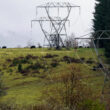Things are happening in Sweet Home.
For years we’ve heard the angst, the complaints that downtown Sweet Home has problems. Empty, blighted commercial buildings. Vagrancy. Tourists who tend to roll on by in their RV’s, headed to the mountains with little thought of stopping and shopping in town.
We’ve voiced some of that ourselves, on this page.
A lot of discussion has gone into how to turn all this around. In 2008, after a couple of downtown revitalization consultants told us that they thought we were basically a lost cause, the Sweet Home Active Revitalization Effort (SHARE) was founded following three heavily attended community meetings that were held in response to the consultants’ verdict.
Of course, the recession that arrived at approximately the same time didn’t help, but some progress was made – downtown buildings painted and other commercial exterior improvements made with grants from SHEDG, the hiring of an economic development director by SHEDG (who kept things moving while the Oregon Jamboree profits that paid his salary lasted), funding for the Farmers Market, a new mural, and more.
During roughly the last decade, Sweet Home has gotten three new department stores – BiMart, Dollar General and the Dollar Tree, a Subway, an often-bustling donut shop, an ice cream shop, a renovated movie theater, a renovated McDonald’s, a brand new contractor-quality hardware store and lots of other upgrades to other local businesses.
This list isn’t comprehensive, and we mention it only to remind ourselves that Sweet Home today is not what it was as we launched into the Great Recession.
But challenges are still there. We continue to have what participants in those 2008 community meetings, all of which drew 100-plus residents, described as a “run down” Main Street commercial district, with property owners who, quoting actual comments from those meetings, have “checked out.”
We have homelessness.
Crossing Main Street can be a daunting prospect, given drivers’ tendency to not acknowledge pedestrians in the crosswalks.
There’s a perceived lack of support for new businesses from both residents and the city.
Business operations are often not geared toward attracting new, or at least increased, customer flow.
And with that steady parade of tourists and other travelers rolling by on Main Street, feeling little inclination to stop here, we have a lot of wasted opportunities. Speaking frankly, people headed to the mountains (or out of them) have little reason to stop and shop, other than for necessities.
None of these complaints are new. Many were articulated in those 2008 meetings.
Now, though, the City Council and staff are making active efforts to address them, and that’s why readers are hearing discussion of livability, park improvements, laws and code changes that would address various challenges ranging from public urination to design requirements and people sleeping on the sidewalk, and more.
As we report on page 1, there’s a focused effort to come up with a plan to address these challenges, to make Sweet Home a better place to live and do business.
Revitalization isn’t easy. It often takes years, concerted efforts on the part of city officials and residents, landowners and business people. It can be expensive, though there is help out there. Sweet Home is taking advantage of such opportunities – such as the $242,000 grant the city has received from the state for Sankey Park improvements, which we reported a couple of weeks ago.
Certainly, there’s no sure guarantee that improvements to downtown buildings and bans on disruptive behavior can turn Sweet Home’s commercial district into a place where prospective developers and business owners would want to spend money and put down roots. But it’s happening elsewhere – including right down the road in Lebanon and Albany.
Think about what those cities’ downtowns looked like 10 or 15 years ago, how much foot traffic they had. Think about how much more inviting they are now.
It can be done, and we have forests and lakes that people already want to come for, not to mention the Oregon Jamboree.
Certainly, it isn’t an easy process.
Sweet Home residents aren’t alone in their desire to be left alone, to simply do what they want. Laws can impinge on such freedoms.
But there are two sides of this coin, and in a community, individual actions (or lack thereof) can negatively affect neighbors and the public at large. That is what’s happened in downtown Sweet Home. That’s why these ordinances are being discussed.
Residents with concerns and ideas, one way or the other, should speak up. This is our community. All of us are players, whether we think that way or not.
City Council meetings are open to the public at 6:30 p.m. on the second and fourth Tuesday of each month, at 3225 Main St. The beginning of each meeting includes an opportunity for public comment on any topic of concern to the speaker.
City staff members, particularly Community and Economic Development Director Blair Larsen, want to hear from residents.
And, readers are always welcome to share their thoughts in letters to the editor, which are published in accordance with the guidelines in the gray box to the right.
Laws that ban what many of us consider obnoxious behavior can be restrictive, and they’re definitely a step away from individual liberty. But if they are passed, it’s usually because individual liberty has been taken to the point that it negatively impacts others.
Yes, it’s going to be a fine line as city officials try to figure out how to address the challenges of taking Sweet Home to a new level of attractiveness and commercial viability. That’s why concerned members of the public really need to get involved.




